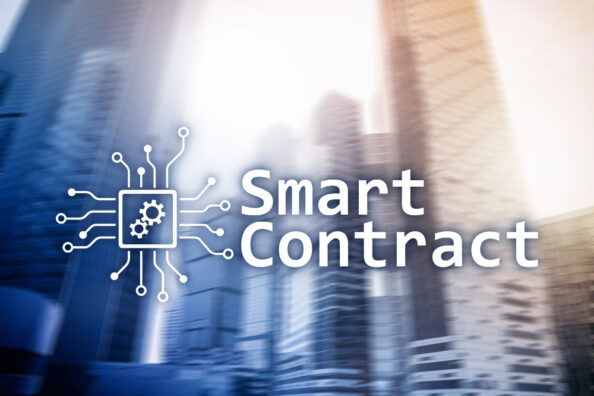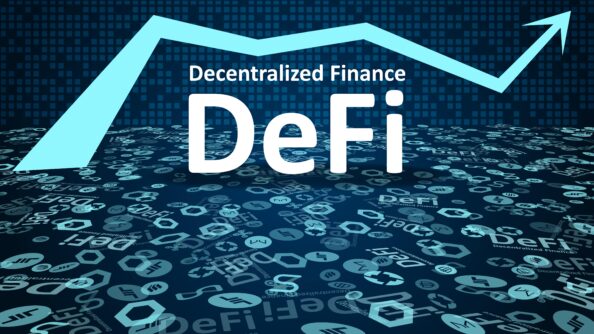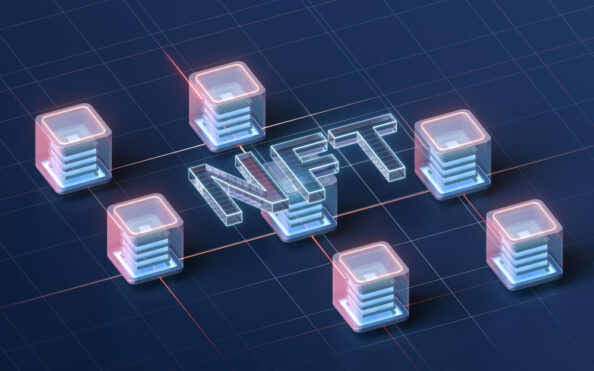
Smart contracts are a significant part of the blockchain revolution. They are autonomous, decentralized, irreversible, and transparent, making them one of the key elements of blockchain-powered ecosystems and application-focused blockchains. Smart contracts are likely to cut transaction costs, eliminate the need for middlemen, automate multiple contracting operations, and reduce risks of fraud.
But are smart contracts the solution we have been looking for? Or are they worthy of our attention and mass adoption?
In this article, we will find answers to these questions and thoroughly examine smart contracts, including their history, their benefits and limitations, use cases, and many more.
Smart contracts are digital agreements between two parties that are executed on a blockchain network. Thus, smart contracts are stored on a public database and stay immutable once deployed. Since smart contracts run on decentralized blockchains rather than on a centralized server, they allow the parties to come to a shared outcome in a precise, timely, and secure manner.
Each contract has a set of predetermined conditions. When these conditions are met, the contract automatically executes and triggers the following events. An executed contract is a signed contract that initiates a contractual connection between two or more parties. Each party assures to maintain the responsibilities they agreed to in the written form once the smart contract is signed.
To sum up, smart contracts are usually used to automate the execution of an agreement so that all parties can make certain of the result as soon as possible without time delay and any intermediary.
Could you imagine that smart contracts long precede blockchain technology? In 1994, cryptographer Nick Szabo came up with the idea of recording agreements in the form of computer code. Those digital agreements reproduced the actions defined in traditional contracts. According to Szabo, the general purposes of smart contracts were to “satisfy common contractual conditions, minimize exceptions both malicious and accidental, and minimize the need for trusted intermediaries.”
Back then, the problem was that blockchain technology didn’t exist. In 2008, Satoshi Nakamoto started Bitcoin, a decentralized payment system where the transaction history is stored in a distributed ledger that consists of blocks. Each block holds a set of transactions, a hash to a previous block, and a timestamp. In 2009, the Bitcoin blockchain was introduced, which supported the first protocol smart contract — creating conditions for transferring Bitcoins between network users.
In 2015, Vitalik Buterin launched Ethereum as a new blockchain for programmable smart contracts. It offered a so-called world computer that may run multiple independent smart contracts at the same time. Today, we have many smart contract platforms that run on various networks, use diverse programming languages and consensus mechanisms, and power numerous businesses and apps.

The idea behind smart contracts is quite uncomplicated. They are just digital “if/when-then” agreements between at least two parties with the security coding of blockchain. There is no limit on how much IF/WHEN and THEN can be included in a smart contract. Once it is deployed, the smart contract gets an address in the blockchain that is used for interacting with the contract and performing actions.
Here are some examples of the IF/WHEN-THEN logic:
Now, let’s see which steps you need to follow when working with smart contracts.
Step 1: Identifying agreement. Multiple parties determine the opportunity for collaboration and discuss the expected outcomes. These agreements may include business processes, asset swaps, and beyond.
Step 2: Setting conditions. Smart contracts may be executed by the parties themselves or when certain triggering conditions are met. For instance, they may be payment authorization, shipment delivery, etc.
Step 3: Coding business logic. At this point, smart contract developers write computer programs that will self-execute when the predefined conditions are met.
Step 4: Using blockchain and encryption. Encryption enables secure authentication and message transfers between parties associated with the smart contract.
Step 5: Execution and processing. In blockchain iteration, the code is executed every time the parties reach a consensus regarding authentication and verification. After that, the results are recorded for further compliance and verification.
Step 6: Network updates. When the smart contract is executed, all network participants, or nodes, update the distributed ledger so that it reflects the new condition. The record cannot be altered when it is broadcast and verified on the blockchain network. Thus, the record is in append mode only.

Speed, Efficiency, and Accuracy
Once the predefined conditions are met, the smart contract self-executes instantly. Since smart contracts are digital and automated, there is no need for dealing with lots of unreliable paperwork. Hence, there will be no time wasted resolving human mistakes that come from manually filling in documents.
Trust and Transparency
No third party is engaged, and encrypted records of transactions are shared among the network participants. Thus, you do not have to worry about data being changed for personal gain as parties undertaking the smart contract supervise all transactions.
Blockchain transaction records are extremely hard to hack as they are encrypted. Each record on a distributed ledger is linked to the ones before and after it, so cyber criminals would have to adjust the entire chain to change a single record. In addition to this, running on a decentralized blockchain means there is no centralized intermediary to corrupt and no mechanism to tamper with the results.
Savings
Smart contracts eliminate the need for middlemen to handle transactions and fees and time delays associated with them.
Even though smart contracts have substantial benefits, they also have to deal with several issues. Let’s see what they are.
External Data Issues
Smart contracts need preliminary information to start execution. For instance, to start processing the payment for Company1, the contract would require preceding information about when the goods from Company2 arrive.
Still, blockchain cannot communicate outside the network. To tackle the issue, smart contract developers use oracles — apps that collect data from outside. Hence, users are obliged to trust that the data provided by the oracle is precise, smart contracts may produce more errors while using multiple oracles increase the transactional costs.
Immutability
The immutability of smart contracts is their benefit and another issue for blockchain at the same time. On the one hand, they remove bad actors that may alter the contract data. On the other hand, it is impossible to fix bugs found in the contract code after its deployment. So, developers have little space to offer bug-fixing solutions when they occur.
Confidentiality Issues
Blockchain uncovers the transaction data of all activities performed by nodes. The data helps guarantee transparency and prevent fraud since users may access it. Still, most users want sensitive data about their smart contracts to be confidential and accessible only to them. So, the lack of privacy obstructs the trust of users greatly.
Legal Issues
When using smart contracts, there is no need for lawyers that witness and sign the agreements. Since no official law controls or governs smart contracts, there are risks of losing the transaction if one party disobeys. So, the lack of legal support is one of the limiting factors to the mass adoption of smart contracts.
Security Concerns
There still may occur errors that may be damaging and have greater influence than usual software bugs. At present, smart contracts are empowering the systems for decentralized finance. Thus, a single weakness may result in substantial losses for the user side.
Simplicity Nature
Smart contracts are simple by nature, which makes them unable to work in hypothetical cases. Any code should not include ambiguous statements that are hard to represent in binary. Smart contracts may be helpful in simple applications where data is easily understood.
To get a better understanding of how contracts work, we need a closer look at them. A regular contract consists of the offer, the acceptance, and the transaction.
To get the idea behind these elements, let’s imagine we agree with the property owner to rent an apartment for five weeks at $50 each week. In this case, the three parts of the contract will be as follows:
The Offer
The offer represents the agreement that we will pay $50 every week for five weeks. The offer specifies the responsibilities of the parties and gives an exchange of value between them.
The Acceptance
Acceptance indicates the agreement between the conditions presented by one party. In our example, the owner would agree to rent the apartment for five weeks, granted we pay $50 each week.
The Transaction
At this point, each party complies with its obligations according to the agreement. In our situation, we pay our $50 as the apartment rent, and the property owner rents us the apartment. Thus, this stage is the one where the contract performance is made.
If the property owner neglects to rent us the apartment key after payment, it will breach the contract. The same occurs if we reject making payment for the second week after finishing the first one.
The contract law clearly states that if any party fails to fulfill the agreement, they may be taken to court for that. Therefore, contracts enable the involved parties to establish trustworthy relations as there is a reliable intermediary to accomplish the agreements.
Smart Contract Use Cases in Finance

Decentralized finance (DeFi) dApps are an alternative to traditional financial services as they provide uses with parallel services to the banking industry such as borrowing, lending, trading, and lots of other financial services. In addition to this, dApps allow for using brand new types of products and decentralized business models that may bring substantial advantages and value for users. DeFi dApps are likely to reduce obstacles that prevent people globally from entering the world of financial services.
NFTs and Smart Contracts: Blockchain Technology in Gaming

Non-fungible tokens (NFTs) are widely spread in the gaming industry. NFTs are unique digital assets that rely on smart contracts and represent in-game content. NFTs are indivisible and rare, while blockchain networks that underpin NFTs enable immutability, interoperability, confirmable scarcity, and player ownership.
Implementing blockchain technology in gaming allows players to save in-game purchases, sell them to other users, and even migrate them to various supported games. In addition to this, blockchain-powered games and dApps are likely to expand gaming economies, create new gaming categories, and prompt the development of new games.
Smart Contracts and Blockchain in the Legal Industry

Smart contracts are an important part of innovation in the legal industry. They are likely to provide parties with legal agreements with reduced costs as there is no need for using lawyers and other intermediaries. At present, some U.S. states allow for creating enforceable legal agreements in the form of smart contracts and issuing marriage licenses with the help of blockchain. Thus, the mass adoption of smart contracts may be closer than we tend to think.
Blockchain in Real Estate

Smart contracts promote the fractional ownership of assets through tokenization. When a part of property is tokenized, much of the necessary record-keeping may take place via related smart contracts which will save the parties time and money as there is less need for legal counsel or other advisory services. Uniting blockchain and real estate transactions also reduces barriers that prevent people from entering the world of investment.
Smart Contracts Uses in Corporate Structures: Building DAOs

Decentralized autonomous organizations (DAOs) may use smart contracts to encode corporate structures and build ownership and compensation rights into them. Such DAOs may create comprehensive, automatically executed structures inside their corporate structures. DAOs may also reduce administrative costs due to incentive structures that may not include formal employment contracts.
Applications of Smart Contracts in Emerging Technology

Smart contracts may get substantial benefits from leading computational capabilities and adaptive systems of artificial intelligence (AI), whereas AI implementations may use smart contracts for their autonomous execution of sets of rules and to build a protected environment for keeping confidential machine learning information. AI-powered smart contracts may facilitate the development of comprehensive and more responsive enterprise-grade dApps and other blockchain solutions.
Voting and Blockchain Implementation of Smart Contracts

Blockchain-powered smart contracts may help governments make voting systems more secure, transparent, and protected from fraud. When a voting transaction is added to the blockchain, it cannot be changed. Thus, elections are always fair, and their winners are always correct.
Potential Smart Contract Advantages in Other Industries

Smart contracts will be possibly used for satisfying the needs of the thriving Internet of Things (IoT) as blockchain technology is already being used to provide IoT devices with higher security and transparency levels.
Healthcare is another example of an industry that has started to implement blockchain technology for improved data sharing. Further integration of smart contracts and dApps may help to solve key healthcare issues such as authentication, identification, and interoperability challenges.
Inability to Scale and Shared Networks
Smart contract platforms are a single blockchain with a shared network by nature. It significantly decreases the number of transactions that the network can execute per second. For instance, the Ethereum blockchain is only capable of processing only 15 transactions per second.
It may seem to be enough for a fully operating network, but more complex applications need to operate thousands of processes per second. Therefore, complicated blockchain-powered apps would cost tens of thousands of dollars to run every hour, which is too expensive for any profit-looking company.
In certain situations, technology is an obstacle rather than a benefit. For instance, network congestion may result in delaying transactions, which will increase the transactional cost compared to traditional contracts.
According to statistics, over 60% of Ethereum smart contracts have never been dealt with, so the network can process less than one transaction per hour for each active project. Hence, third-party projects compete to cover the limited amount of available transaction slots.
Adaptability
Logic-based execution might be confusing and tough for law firms. Contract structure is pretty abstract, and such phrases as “best efforts” or “reasonable” are deliberately included to leave enough space for flexibility. This type of contract is required when the parties are willing to form a relational contract instead of a transactional one. In such situations, smart contracts are useless.
Even though smart contracts eliminate the need for middlemen and lawyers, all parties must be aware of the legal implications of commercial, criminal, private, and public law. Smart contract implementation guarantees that the terms are followed as decided upon.
Insecure Smart Contracts
Decentralization has also led to the lack of security audits of smart contracts that run on platforms. In other words, anyone may run any smart contract as long as they pay the gas fees. Thus, even offensive smart contracts with substantial security weaknesses may be run on platforms.
Since most smart contracts on the first generation of blockchain platforms are based on balance, an error in one uncovers all addresses related to that contract. So, if malicious users find a bug and successfully utilize it, then they will be able to steal funds from all addresses that have ever made transactions with the damaged system.
Third Parties
Even though smart contracts strive to get rid of third-party involvement, it is impossible to do so. Here, they play different roles compared to traditional contracts. For instance, lawyers do not have to write individual contracts, while developers may call for their help to understand the arrangements and build smart contract solutions.

Ethereum is the biggest platform for decentralized applications as it hosts the majority of active dApps. It introduced smart contract programmability inside the blockchain ecosystem. Ethereum is moving to proof-of-stake (PoS) while substantial scalability resources are being created to increase throughput powered by Ethereum’s built-in security features. The platform’s native asset is ETH.
The Bitcoin network acts as a huge distributed mediator that accomplishes the proper execution of smart contracts without the need for depending on a single central authority to do so. It provides smart contracts with a mechanism that makes them enforceable, observable, and verifiable. However, all the terms of Bitcoin smart contracts are entirely public. Still, the network protects the real identities of the engaged parties.
Cardano is a blockchain platform that strives to be decentralized, scalable, sustainable, and suitable for running smart contracts. Its native asset is ADA. At present, Cardano is widely spread in supply chain management. The Alonzo mainnet upgrade introduced a special language for the network that allows for writing financial contracts in the financial language. It is expected that smart contracts will become accessible on mobile devices downloading the entire blockchain.
Solana is a swift, high-performance, and scalable network with SOL as a native asset. This blockchain is rapidly developing as it offers fast and cheap transactions. Solana supports smart contracts written in C, C++, and Rust languages.
This blockchain is popular with decentralized finance projects since it can process thousands of transactions per second. Also, Solana hosts NFT marketplaces and Chainlink, the decentralized oracle network.
Avalanche blockchain is one of the most popular networks as it addresses the blockchain trilemma of decentralization, scalability, and security. The blockchain features multiple chains including subnets that are an important part of Avalanche’s offered scaling solution. The subnets are compatible with any virtual machine and smart contract package which allows developers to be flexible and have control over applications. Avalanche’s native asset is AVAX.

Cosmos is a layer 0 blockchain with several validators and inter-blockchain communications protocol. In other words, it strives to build an ecosystem made of blockchains that interact with each other. You can use Cosmos as a platform for scalable smart contracts and as a legal tender in the decentralized world. Tendermint, the consensus algorithm of Cosmos, facilitates new levels of scalability and it can reach more than 10,000 transactions per second, which will make Cosmos one of the most efficient platforms for smart contracts.
Near processes transactions swiftly and securely. However, it is pretty centralized nowadays as it has several validators. It is built on a layer 1 blockchain and uses the delegated proof-of-stake consensus mechanism to enable security and scalability. The reason why Near is popular is its Aurora system. Aurora is a layer 2 scaling solution that makes it easy for developers to copy their Ethereum apps onto the Aurora network.
Elrond Protocol
Elrond is a smart contract platform that helps users make certain the contract execution takes place in the correct order and on the right shard. The platform also assigns and moves smart contracts to the shards where their static dependencies are, which eliminates cross-shard locking/unlocking. Elrond switches between network sharding, state sharding, and transaction sharding to make its capacity flexible. In addition to this, developers can code on the Elrond Virtual Machine in any programming language.
The Algorand Blockchain
Algorand is a network that is popular with asset issuers and asset management platforms. It is a relatively cheap platform that processes 1,000 transactions per second. Algorand’s smart contracts can satisfy the needs of almost any decentralized application. The platform uses Clarity, Python, and Reach programming languages as they provide developers with the right balance.
Polkadot is not a smart contract platform by nature, it is an ecosystem that unites individual blockchains under one network. Polkadot has parachains linked to the relay chain, so these parachains support smart contracts and can interact with each other. Thus, Moonbeam was launched to enable smart contract functionality and allow developers to create natively interoperable dApps.

There are several challenges that smart contracts face. For instance, smart contracts lack confidentiality and are excessively open, which may discourage many prospective users. The scalability issue should also be tackled since a widely spread technology must be both affordable and high-performance.
All in all, smart contracts are a promising technology, but there is still room for improvement. The blockchain community supports further development of the technology and strives to make it our reality in the future. Smart contracts may become adopted by the masses when their drawbacks are addressed.
If you have any questions or bright ideas, don’t hesitate to contact our expert team.